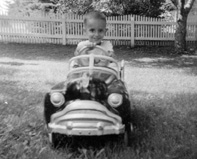THE PLAN
After coaxing the purely stock 2.0 liter engine in my TR7 land speed roadster to 111.715 miles per hour at the East Coast Timing Association’s one mile land speed course, I realized that to make any significant improvement in my top speeds I would need a bigger bullet.
After talking with my good friend and co-driver, Tony, we decided to skip the step of building an intermediate competition engine and go straight to a full race tune mill.
THE BULLET
In that land speed racing does not produce excessive heat or engine stress and the runs are less than a minute in length, we elected to use a stock crankshaft and stock connecting rods. Pistons are 12 to 1 Venolia with tall domes. The camshaft is a full race Crane grind good for 7800rpm. This cam set up comes with dual valve springs and aluminum retainers. The intake and carb system are dual 40mm DCOE Webers.

 The cylinder head modifications are very mild for our first version because we weren’t sure we could get the diagonal bolted cylinder head to seal at such high compression. (we didn’t want to invest a lot of time and money on a head if we were going to blow it up!) We also selected a solid copper head gasket to help seal the combustion chambers.
The cylinder head modifications are very mild for our first version because we weren’t sure we could get the diagonal bolted cylinder head to seal at such high compression. (we didn’t want to invest a lot of time and money on a head if we were going to blow it up!) We also selected a solid copper head gasket to help seal the combustion chambers.
THE TRIBULATIONS
First Attempt:
We assembled the engine using Copper Cote to seal the head gasket. We installed the engine, attached the exhaust, wired and plumbed it. The engine fired and ran, but we were unsuccessful in sealing the water jackets. No matter how we tried we couldn’t get it to seal. We left the engine in the car, pulled the intake and the head and started over.
Second Attempt: (two weeks later)
On-line research led us to a head sealant known as Hylomar, originally developed for use on jet engines. We completely cleaned all head surfaces and the copper head gasket and started over with Hylomar. One again our engine fired and sounded great. What a sound made by 12 to 1 pistons at 7,000 rpm. The head seemed to be sealing. On or 5th heat cycle for the engine we were tuning the crank trigger ignition. The engine was at a happy idle when it suddenly stopped. A tear down revealed a broken retainer on the number one exhaust valve. The broken retainer caused the valve to drop, the domed piston happily pushed the valve straight back into the guide breaking the cam follower and chipping the cam lobe. Luckily the engine broke at idle. The only casualties was the cam, a valve and a retainer. By now I was feeling really good about that decision NOT to spend a lot of money on cylinder head modifications.
Third Attempt: (the charm?)
Tony and I pulled the engine back out of the car, removed the intake and head and once again cleaned all the surfaces. We sent the cam off to our machine shop for refinishing and ordered up a new set of retainers. This engine failure forced us to cancel our plans to make the September event in Maxton. By mid-September the cam was back from the machine shop and we had upgraded our spring retainers from aluminum to titanium. Additional changes to build number 3 were: we sawed off the water outlet from the Weber intake manifold and had an outlet sleeve welded directly to the cylinder head, and we elected to try a stock head gasket. We also re-shimmed the valve springs to eliminate possible binding under full compression. The engine was finally re-assembled and dropped back into the race car. Once again it fired up and sounded great. We would meet again in November to tune the engine and set the crank trigger ignition.
![DSC00931 144[1]](http://flashbackracing.com/wp-content/uploads/2010/02/DSC00931-1441.jpg)
